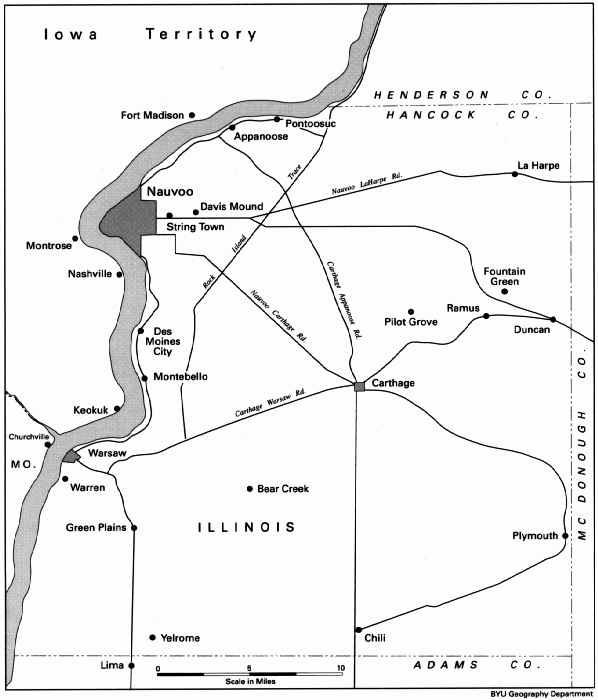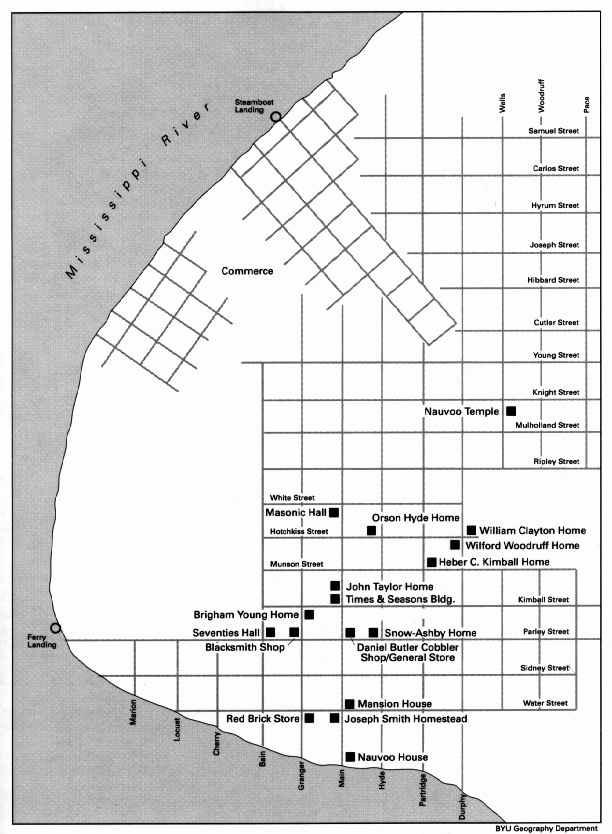Article "Nauvoo"
(by Glen M. Leonhard; pp.987-993)Nauvoo was the home of the LDS from 1839 to 1846, from the time they fled the Missouri persecutions in the 1838-9 [in what is commonly called the Mormon War, RCK] to the exodus west to the Rockies [after the death of Joseph Smith Jr, RCK] (p.987). Nauvoo was the main settlement of an area extending from Eastern Iowa to Western Illinois where the LDS found refuge.
Nauvoo grew on
land purchased from settlers and speculators willing to sell on contract (Vol 3. p.987)For example
Joseph Smith [Jr, RCK] acting as agent for the Church, bought the Illinois farms of Hugh & William White and investment tracts from Isac Galland and Horace Hotchkiss—in all, 660 acres.(Vol 3. p.987)Smith Jr sold 1 acre lots on the river flats, other LDS developers sold lots on the buffs. The area had been mapped out with the "paper" towns of Commerce and Commerce City, but a new layout of streets three rods wide took its place.
In 1840, the Illinois legislature issued the Nauvoo Charter, which made Nauvoo a legal entity.
Not only Ohio and Missouri LDS came to Nauvoo (p.990), but also newly missionized members from the United States, Canada and Britain (due to the success of the Missions of the Twelf to the British Isles). The converts used a plurality of modes of transport.
Some used canal boats and lake steamers, others covered wagons and horseback, and a few simly walked. (p.990)
Beginning in 1840, thousands sailed the Atlantic from Liverpool, England, and took steamboats up the Mississippi from New Orleans. (p.990)The migrations (see also Art. Immigration and Emigration) were assisted by the Church
[The migraints were] aided by Church emigration agents in Liverpool, who organized companies and appointed shepherds for those fleeing to Zion .... (p.990)The influx was more than the boom town could handle.
Renting a room or finding other temporary quarters became increasinglz difficult during the boom years 1841-1843. (p.990)While resources such as lumber and clay for brick making was available, the contractors were scarce.
Pictures
Joseph Smith [Jr, RCK] and his family moved into the Mansion House in August 1843. Later a wing was added to the east side of the main structure for a total of twenty-two rooms. Beginning in January 1844, Ebenezer Robinson managed the Mansion House as a hotel, and the Prophet maintained six rooms for himself and his family. Emma Smith lived here until 1871, when she moved into the Nauvoo House, where she died in 1879.
(Caption, p.990)




No comments:
Post a Comment